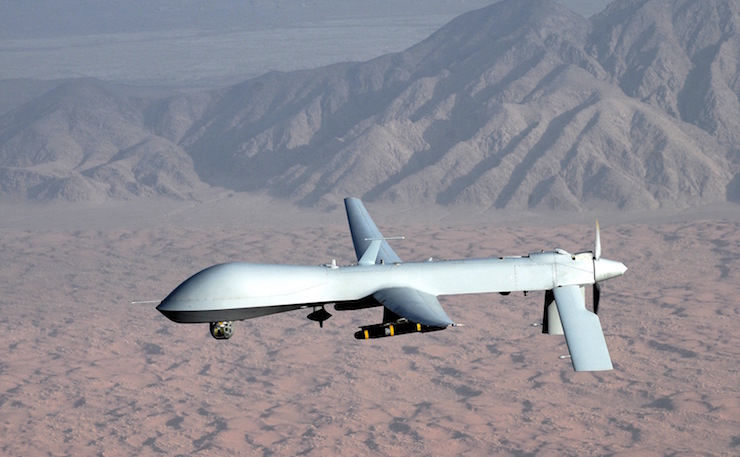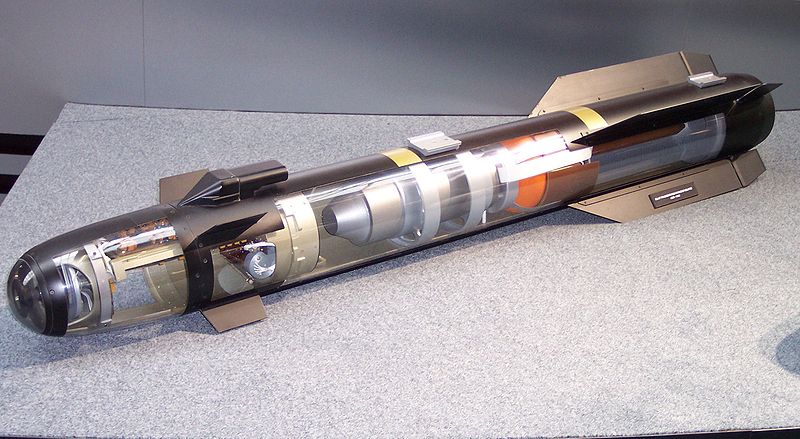ANALYSIS: A new Defence plan proposes that billions be spent on bringing drones to Australia. But as the War on Terror has demonstrated, the pilotless killing machines are anything but precise. Buying into the technology will cost Australia more than the hefty purchase price, writes Alex Edney-Browne.
Late last month, the Australian Department of Defence released its 2016 White Paper outlining Australia’s defence spending and strategy until 2035.
Comprising 191 pages of dry prose, the Paper is unlikely to have been read by anyone other than military enthusiasts and dedicated journalists. The report should, however, be an interesting read given Australia is approaching its fifteenth year of involvement in the sprawling “War on Terror” (now a fight against ISIS, al Qaeda, al Nusra and al Shabaab). One might expect to see some insightful feedback on Australia’s fifteen years of support in the US-led war.
Remarkably, the White Paper is so unreflective it could have been published in 2003. The United States and its role in ensuring “global security” in the face of terrorism is uncritically celebrated. The Australian government’s desire to maintain strong military ties to the US is stressed throughout, as is the need for increased “interoperability” of Australian and US weapons systems:
“The United States will remain the pre-eminent global military power over the next two decades. It will continue to be Australia’s most important strategic partner through our longstanding alliance…” (41)
“The ADF (Australian Defence Force) will need to maintain a high degree of interoperability with the sophisticated capabilities which the United States deploys when it leads international coalitions to address global security challenges.” (77)
“We will emphasise capabilities that allow us to operate more seamlessly with United States forces…” (122)
Given the United States’ heavy reliance on drones, “a high degree of interoperability” with US weapons systems requires the Australian Defence Force to develop its own drone warfare capabilities. While the now-loaded term “drone” is never used, the Paper states that the Australian government is investing three to four billion dollars into a “High Altitude Unmanned Intelligence, Surveillance and Reconnaissance (ISR) System”, with a further one to two billion going into “Armed ISR Unmanned Aircraft”.
“… acquisition of an advanced armed, medium-altitude long-endurance unmanned aircraft for an integrated and persistent intelligence, surveillance, reconnaissance and attack capability to support ADF and coalition forces is programmed for the early 2020s.” (115).
Simply put, the Australian Department of Defence will start developing its own fleet of both unarmed and armed surveillance drones within four to eight years.
The fifteenth anniversary of the War on Terror also marks the introduction of the UK Royal Air Force’s Brimstone missiles, deployed for the first time in early January in airstrikes against ISIS. According to the UK’s Conservative government, these missiles are highly sophisticated: they can hit targets with pinpoint accuracy and minimise the amount of shrapnel created upon impact, thus preventing civilian casualties.

Clean Words And Dirty Wars
As both the Australian White Paper and the UK government’s Brimstone missile hype illustrate, it is easy for Coalition governments to talk about war in the most clean and sanitising of ways. You are likely not alone if you’ve read up until here without once thinking about dead bodies, lost limbs, shrapnel wounds, traumatised children, or destroyed homes. Hiding the bloody realities of the war has been made all the easier by the techno-fetishisation of weaponry.
The War on Terror has been fought with drone strikes, laser-guided missiles and GPS-guided bombs. Civilian casualties are allegedly few and far between, if not non-existent (the UK government still claims to have not killed a single civilian in the last 18 months of airstrikes in Iraq). Even the “Shock and Awe” bombing of Baghdad, Mosul, and Kirkuk in 2003 – a mass aerial bombardment that killed an average of 317 civilians per day for 6 weeks – was claimed by Pentagon officials at the time to be a highly co-ordinated campaign that only killed terrorists.
High-technology weapons, however, have not made warfare any less horrific. It is important we understand what kind of weapons the US-Coalition has used so far in the War on Terror and what increased “interoperability” with the United States might entail for Australia.
Being Precise About Imprecision

Precision-Guided Munitions (PGMs) or “smart bombs” have been a staple of the US-Coalition’s arsenal since the beginning of the War on Terror. Now, all airstrikes in the fight against ISIS use precision-guided technology. PGMs are weapons that allegedly – through laser, GPS or satellite technology – minimise the risk of injury or death to civilians by specifically targeting combatants: “putting warheads on foreheads” as US Air Force officers call it. This may sound compelling in theory, but it is important we realise precision targeting is mythical in practice.
Laser-guided and GPS-guided munitions, for example, only land within their target radius 50 per cent of the time (an undeniably huge margin of error). Furthermore, the target radius for each of these munitions is three to eight metres and 10 – 13 metres respectively. This means that when innocent people up to eight and 13 metres away are killed, strikes are still considered “on target”. Amidst all the hype about “surgical precision”, it’s also easy to forget the obvious: missiles and bombs produce deadly blast waves that endanger the lives of everyone inside the blast radius. For 500–2000 pound munitions, the blast radius is between 500 and 1000 metres, meaning that anyone up to one kilometre away from a target can be killed or injured in US-Coalition attacks. Putting warheads on foreheads is a practical impossibility no matter how technologically sophisticated Western warfare seems to be.
The Problem With ‘Signature Strikes’
The problems with precision outlined above also plague drone technology. The blast radius of a Hellfire missile (the most frequently used in drone strikes) is between 15 and 20 metres. Once again, it is impossible to ensure that people killed or wounded by drone strikes are the intended targets of the attack. Increasingly, the US is carrying out “signature strikes” where the identity of the target is unknown, but available intelligence on their behaviour suggests terrorist activity. Signature strikes often target the GPS signals of an individual’s mobile phone. If that mobile phone changes hands, the new owner of the mobile phone (and the people nearby) will be killed.
There is also the issue of correctly identifying “appropriate” targets in signature strikes. The identification process has been increasingly automated, undertaken by algorithms rather than humans. Signature strikes involve the codifying of individual’s daily movements, including whom they meet with and talk to on the phone. If anything deemed suspicious crops up (including deviations in an individual’s “normal routine”), this person becomes a legitimate target. Of course it does not logically follow that because someone is walking a different way to buy their groceries today, they must be having a covert meeting with a Taliban commander. The algorithms are not complex enough to take this into account.
Signature strike algorithms also use quantitative rather than qualitative data. As author of Drone Theory Gregoire Chamayou argues, “group membership [is]deduced from the number and frequency of contacts, regardless of their nature”. A friend or family member of a suspected terrorist can therefore become a legitimate target by association.
In drone warfare, life or death decisions are made on the basis of such un-nuanced intelligence. With this in mind, it is unsurprising that a 2014 report by UK based organisation Reprieve found that US drone strikes had killed 1147 people in the process of trying to kill 41. Likewise, The Intercept’s “Drone Papers” released last year reveal that in one five-month period of drone strikes in Afghanistan, 90 per cent of drone victims were not the intended targets. Despite this, the Australian government intends to invest four to six billion dollars into this technology.
Fire In The Sky

Drones also carry and deploy Hellfire missiles. These missiles – as their name suggests – burn their targets. Characterised as “thermobaric weapons”, hellfire missiles have a layer of “fluorinated aluminium powder between the warhead casing and the explosive fill”. As the explosive fill detonates, “the aluminium mixture is dispersed and rapidly burns”.
In simple terms, Hellfire missiles are purposefully designed with the aim of incineration. Then 9-year-old Pakistani girl Nabila Rehman witnessed these horrific effects first-hand in 2013 when her grandmother, Momina Bibi, was struck by a Hellfire missile and suffered severe burns leading to her death. Nabila also suffered severe burns and shrapnel wounds in the attack. As Glenn Greenwald writes in his distressing piece “Burning Victims to Death: Still a Common Practice”, bodies are often so burnt in US-Coalition drone strikes that victims are unable to be identified. This makes it near impossible to provide proper burials for individuals who have died in attacks. One doctor who has treated drone victims states that “bodies are so burnt you can’t tell cattle from human”.
If you were thinking drone warfare couldn’t get any more horrific, those who come to the aid of people in drone attacks in Pakistan and Yemen often end up wounded or dead. Known as “double taps”, CIA drone strikes have been reported as coming in rounds of two: first to kill the initial targets and again slightly later to hit the first responders (this is allegedly based on the assumption that those proximate to suspected terrorists are likely terrorists too). A 2012 report by the Bureau of Investigative Journalism found that at least 50 civilians in Pakistan had been killed in these follow up strikes as they ran to help the wounded.
Chemical Weapons
Of all the horrors of US Coalition’s war effort, perhaps the least known is the use of chemical weapons and the long-lasting effects these have had on communities in Iraq. War pollution from the use of white phosphorous and depleted uranium munitions during the invasion of Iraq has correlated with an epidemic of birth defects, particularly in the cities of Fallujah and Basrah. According to one academic study, “since 2003, congenital malformations have increased to account for 15 per cent of all births”. In this Democracy Now! interview journalist Dar Jamail recounts a meeting he had with Dr Samira Alani, a paediatrician working in Fallujah:
“She said it’s common now in Fallujah for newborns to come out with multiple systemic defects, immune problems, massive central nervous system problems, heart problems, skeletal disorders, babies being born with two heads, cyclops babies literally with one eye – really horrific nightmarish types of birth defects.”
The Assad regime’s use of chemical weaponry against Syrian citizens has been rightly condemned by the US and much of the Western world including Australia. This condemnation, however, is surely hypocritical when the US-Coalition does not publicly acknowledge, formally apologise and – insofar as one can even begin to – make amends for the use of white phosphorous and depleted uranium munitions in Iraq.
Confronting Reality
As harrowing as all these things may sound, nothing compares to experiencing such horrors first hand. We don’t know the pain of Maqded Tuaiman in Yemen, who came across the burnt remains of his 13-year-old brother, killed by a Hellfire missile; or Waleed Shiraz from Pakistan who was studying for his BA but is now disabled and can no longer walk; or toddler Sayef Abdulaziz Mohamed in Fallujah, Iraq, who was born blind and paralysed. It is these embodied experiences of war that are hidden in discussions of the US-Coalition’s technological prowess.
So, when the Australian Department of Defence’s 2016 White Paper boasts that “scientific and technological sophistication” will create “a capable, agile and potent” future force, we need to think about what this means in reality for those living in war zones. The Government’s potential investment in drone technology should not slip by unnoticed. To remain silent about the horrors of the US-led War on Terror and our part in them facilitates their continuation.
Donate To New Matilda
New Matilda is a small, independent media outlet. We survive through reader contributions, and never losing a lawsuit. If you got something from this article, giving something back helps us to continue speaking truth to power. Every little bit counts.





